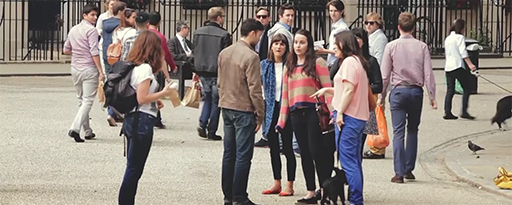9.3 Vulnerability and Unconscious Bias
Activity 2
As you watch this short video clip take a look at the different levels of violence, and at how the onlookers react each time: the video is by MANKIND and is called Violence is Violence. The video raises a number of issues around the gendered nature of domestic abuse. The focus of this section is to look at how we perceive people. To find out more about male victims of domestic abuse please look at the domestic abuse modules which start with the Introduction to domestic abuse [Tip: hold Ctrl and click a link to open it in a new tab. (Hide tip)] module.
Please note that this next video contains strong language and some violence. You are not obliged to watch it if you do not wish to.

Transcript
[STREET NOISES]
[PIGEONS]
[REWINDING]
[STREET NOISE]
Why do you think the onlookers intervened the first time round but not the second?
Comment
The woman protagonist was far more aggressive and violent and yet the onlookers did not intervene – in fact, they thought it was funny. This is almost certainly because the onlookers did not see the man as vulnerable and so did not intervene the second time.
Our unconscious bias makes it hard for us to recognise when someone might be vulnerable. Unconscious bias happens when our brains make incredibly quick judgments and assessments of people and situations without us realising. Often these are based on social stereotypes, which we may not even realise we hold. For example, sometimes the things that appear to make someone strong - status, profession, wealth - might actually make them vulnerable.
At Support Through Court we believe all litigants in person are vulnerable, simply through having to navigate a system designed for professional lawyers. However, there are degrees of vulnerability. In certain circumstances multiple vulnerabilities can make it extremely difficult for an individual to cope with navigating the court process.
The diagram illustrates how multiple characteristics may combine to increase vulnerability.
For example: domestic abuse is a significant factor in a person’s vulnerability and may affect them in a number of ways during the proceedings.
Activity 3
Can you think of a way how experiencing domestic abuse may affect a client, bearing in mind how such a person may be feeling about coming to court?
Comment
For some people, domestic abuse has a magnifying effect on pre-existing vulnerabilities. For example, an already anxious individual who has experienced domestic abuse is likely to be extremely anxious at the thought of facing their abuser in court. For other people, abuse may trigger vulnerabilities such as depression and alcohol dependence.
In these cases the vulnerabilities are often situational and the person finds that their symptoms diminish as they gain distance from the abusive relationship. However, they often return as the relationship is revisited through the court proceedings and the survivor once again comes into contact with their abuser.
Did you know?
It is important to remember that vulnerability may not be constant, consistent or continuous within an individual. Someone who could be regarded as vulnerable at the initial stage of a case might not be vulnerable by the final hearing and vice versa.
Turning to our case study involving the Johnson/Smith family, you may recall that Jazmin Johnson and Steve Smith have separated and are now involved in court proceedings regarding where their child Chloe will live. Click for a reminder about the Johnson/Smith family and their situation.
Activity 4
Would either Steve Smith or Jazmin Johnson be regarded as vulnerable by the courts and if so, why?
Comment
From the information available, Steve is unlikely to be regarded as vulnerable. However, Jazmin Johnson may be vulnerable as her ability to take part in court proceedings may be affected by her being a domestic abuse survivor. She also has a low income, being reliant on benefits and living in emergency accommodation since her separation from Steve.
9.2 What is Vulnerability?

